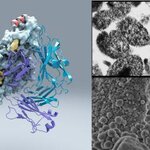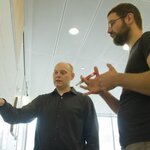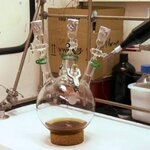Genetics & Molecular Biology

A drug given to pregnant mice with models of autism prevents autistic behavior in their offspring, according to a new report, and though the drug could not be administered prenatally in humans - there is no way to screen for autism in human fetuses - clinical trials of this drug administered later in development, in young children who have already developed autistic symptoms, have showm promise.
The causes of autism spectrum disorder, or ASD, are complex and not well understood.
Prolonged excitation of brain neurons seems partly to blame. GABA -- the main inhibitory neurotransmitter in…

Researchers have discovered an unusual bacterial protein that attaches to virtually any antibody and prevents it from binding to its target. Protein M, as it is called, probably helps some bacteria evade the immune response and establish long-term infections.
If follow-up studies confirm Protein M's ability to defeat the antibody response, it is likely to become a target of new antibacterial therapies. The protein's unique ability to bind generally to antibodies also should make it a valuable tool for research and drug development.
"What Protein M does to antibodies represents a very clever…

Why do men and women have different heights? Why do people have different predispositions to BMI, blood pressure and lipid levels?
Chromosome X is one of the two sex-determining chromosomes and researchers from the University of Helsinki set out to analyze the commonly occurring genetic variation in chromosome X to find genetic factors that could explain individual differences in various traits.
Hundreds of genetic variants having an effect on these traits have already been identified but the X chromosome has not been studied in most of previous studies. 25,000 Northern…

Vaccines are the safest, cheapest and most effective way
to protect against infectious diseases but to make a good one remains a
challenge, and traditional approaches are now stretched to the limit while
fatal diseases, like HIV and malaria, remain without vaccine. But a major breakthrough that turns vaccine design on its head has now been published in Nature on the 6th of February - a new computational method that, from the protective antibodies of patients, can design the vaccine specific to induce them (and protect against the disease).Showing the potential of the new…

People with high blood pressure are familiar with ACE inhibitors, drugs that widen blood vessels by limiting activity of ACE, angiotensin-converting enzyme, a naturally occurring protein found in tissues throughout the body.
But high activity of ACE may sometimes be a good thing. A study conducted by Cedars-Sinai scientists found that genetically targeting certain immune blood cells to overproduce the enzyme broke down defective proteins in the brain associated with Alzheimer's disease and prevented cognitive decline in laboratory mice bred to model the disease.
The study demonstrates…

Normally, a tissue injury causes cells to repair damaged tissue and restore the skin to a normal, homeostatic, state. Errors in this process can give rise to various problems, such as chronic inflammation, which is a known cause of certain cancers.
"It has been noted that cancer resembles a state of chronic wound healing, in which the wound-healing program is erroneously activated and perpetuated," says Professor Adrian Krainer of Cold Spring Harbor Laboratory (CSHL). In a paper published today in Nature Structural&Molecular Biology, a team led by Dr. Krainer reports that a protein…

By analyzing whole-genome sequencing data from 665 people from Europe and East Asia as part of the 1,000 Genomes Project, researchers have determined that more than 20 percent of the Neanderthal genome survives in the DNA of this contemporary group.
That means a substantial fraction of the Neanderthal genome persists in modern human populations. Neanderthals became extinct about 30,000 years ago but their time on earth and their geographic range overlapped with us.
Previous research proposed that someone of non-African descent may have inherited approximately 1 percent…

Prion proteins are "misfolded"and cause a group of incurable neurodegenerative diseases, including spongiform encephalopathies (for example, mad cow diseases) and Creutzfeldt-Jakob disease.
Prions are unique infective agents. Unlike viruses, bacteria, fungi and other parasites, prions do not contain either DNA or RNA. Despite their seemingly simple structure, they can propagate their pathological effects like wildfire, by "infecting" normal proteins.
PrPSc (the pathological form of the prion protein) can induce normal prion proteins (PrPC) to acquire the wrong conformation and convert…

Human induced-pluripotent stem cells (iPSCs) derived from human umbilical cord-blood are capable of repairing damaged retinal vascular tissue in mice, according to a new paper.
The adult stem cells were coaxed turned into an embryonic-like state without the conventional use of viruses, which can mutate genes (and thus initiate cancers) and paves the way for regenerative medicine using a stem cell bank of cord-blood derived iPSCs.
In their paper, Johns Hopkins University biologist Elias Zambidis, M.D., Ph.D., and colleagues describe experiments with these non-viral, human retinal iPSCs…

A new protocol for conducting Miller-Urey Experiments is comprised of a modern and simplified approach to the method used by Dr. Stanley Miller and Dr. Harold Urey in 1953. Their research evaluated the possibility of organic compounds important for the origin of life to have been formed abiologically on early Earth.
Miller-Urey experiments study the abiotic synthesis of organic compounds by creating an environment similar to that of the early earth. An electric discharge is applied to a mixture of gases representing the early earth's atmosphere and lightening. This is done in the…